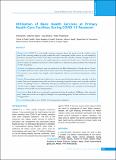Please use this identifier to cite or link to this item:
https://hdl.handle.net/20.500.14356/940Full metadata record
| DC Field | Value | Language |
|---|---|---|
| dc.contributor.author | Basnet, Anita | - |
| dc.contributor.author | Subedi, Baburam | - |
| dc.contributor.author | Bhushal, Suraj | - |
| dc.contributor.author | Baral, Kedar Prasad | - |
| dc.date.accessioned | 2023-04-06T09:57:03Z | - |
| dc.date.available | 2023-04-06T09:57:03Z | - |
| dc.date.issued | 2022 | - |
| dc.identifier.citation | BasnetA., SubediB., BhushalS., & BaralK. P. (2023). Utilization of Basic Health Services at Primary Health Care Facilities During COVID-19 Pandemic. Journal of Nepal Health Research Council, 20(3), 645-652. https://doi.org/10.33314/jnhrc.v20i3.3957 | en_US |
| dc.identifier.issn | Print ISSN: 1727-5482; Online ISSN: 1999-6217 | - |
| dc.identifier.uri | http://103.69.126.140:8080/handle/20.500.14356/940 | - |
| dc.description | Original Article | en_US |
| dc.description.abstract | Abstract Background: COVID-19, a novel rapidly emerging respiratory disease has spread across the world in a short span of time, infecting millions of people around the world. Consequently, health systems are overwhelmed by both direct mortality from COVID-19 and indirect mortality from other treatable conditions. Though COVID-19 prevention and control is crucial, it is also equally important to continue basic health services. Therefore, the study aimed to explore the facilitators and barriers of basic health service utilization at primary health facilities during the COVID-19 pandemic. Methods: An exploratory qualitative study was conducted in the Bidur Municipality of Nuwakot district. Twenty-five telephone interviews were conducted from all the wards of the municipality and each lasted at least 20 minutes. The interviews were translated into English, coded using RQDA software, and analyzed using thematic analysis manually. Results: The participants shared basic health service was interrupted during the pandemic, especially in the first month. However, the prominent factors that were often crosscutting to many factors were socio-economic conditions and fear of acquiring COVID-19. Additionally, inadequate personal protective equipment, mental stress, shortage of health workers, supplies disruptions, social stigma and extended lockdowns come into play for determining the utilization of basic health services during pandemic. Conclusions: Basic health service was heavily compromised during the pandemic. Fulfillment of the sanctioned posts, enhancement in the use of digital technologies can be promoting options for basic health service utilization during pandemic. Keywords: Basic health services; COVID-19; Nepal; pandemic; utilization. | en_US |
| dc.language.iso | en | en_US |
| dc.publisher | Nepal Health Research Council | en_US |
| dc.relation.ispartofseries | July-Sep, 2022;3957 | - |
| dc.subject | Basic health services | en_US |
| dc.subject | COVID-19 | en_US |
| dc.subject | Nepal | en_US |
| dc.subject | Pandemic | en_US |
| dc.subject | Utilization | en_US |
| dc.title | Utilization of Basic Health Services at Primary Health Care Facilities During COVID-19 Pandemic | en_US |
| dc.type | Journal Article | en_US |
| Appears in Collections: | Vol 20 No 3 Issue 56 july-Sep, 2022 | |
Files in This Item:
| File | Description | Size | Format | |
|---|---|---|---|---|
| 3957-Manuscript-30770-1-10-20230314.pdf | Fulltext Article. | 240.21 kB | Adobe PDF |  View/Open |
Items in DSpace are protected by copyright, with all rights reserved, unless otherwise indicated.
